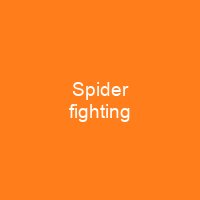In the Philippines, spider fighting is staged between female orb-weavers from the genus Neoscona. In Japan, the contests occur at an annual festival and use females of the genus Argiope. Top fighters can fetch up to 100 pesos, making the sport lucrative for children. Adults also also fight in a way similar to cockfighting.
About Spider fighting in brief

The police also say that spider fighting itself is not illegal as a pastime, but will be considered illegal on the night of the fights once the bets are placed. The fights are done with a single piece of dried coconut leaf midrib or bamboo. Spiders are placed at both ends and encouraged to move toward each other and fight. Non-lethal matches end when one spider falls from the stick. Occasionally, the child holding the stick may need to quickly intervene in a non-lethal fight to prevent the winning spider from eating the losing spider. More formal fights, called ‘kaka derbies’ are held in an arena made of two poles connected by a tight string.
You want to know more about Spider fighting?
This page is based on the article Spider fighting published in Wikipedia (as of Dec. 23, 2020) and was automatically summarized using artificial intelligence.







